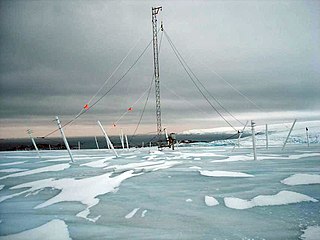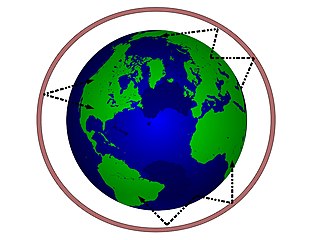
Shortwave radio is radio transmission using radio frequencies in the shortwave bands (SW). There is no official definition of the band range, but it always includes all of the high frequency band (HF), which extends from 3 to 30 MHz. It lies between the medium frequency band (MF) and the bottom of the VHF band.

Very low frequency or VLF is the ITU designation for radio frequencies (RF) in the range of 3–30 kHz, corresponding to wavelengths from 100 to 10 km, respectively. The band is also known as the myriameter band or myriameter wave as the wavelengths range from one to ten myriameters. Due to its limited bandwidth, audio (voice) transmission is highly impractical in this band, and therefore only low-data-rate coded signals are used. The VLF band is used for a few radio navigation services, government time radio stations and secure military communication. Since VLF waves can penetrate at least 40 meters (131 ft) into saltwater, they are used for military communication with submarines.
Low frequency (LF) is the ITU designation for radio frequencies (RF) in the range of 30–300 kHz. Since its wavelengths range from 10–1 km, respectively, it is also known as the kilometre band or kilometre waves.

Medium frequency (MF) is the ITU designation for radio frequencies (RF) in the range of 300 kilohertz (kHz) to 3 megahertz (MHz). Part of this band is the medium wave (MW) AM broadcast band. The MF band is also known as the hectometer band as the wavelengths range from ten to one hectometers. Frequencies immediately below MF are denoted as low frequency (LF), while the first band of higher frequencies is known as high frequency (HF). MF is mostly used for AM radio broadcasting, navigational radio beacons, maritime ship-to-shore communication, and transoceanic air traffic control.

In radio, longwave, long wave or long-wave, and commonly abbreviated LW, refers to parts of the radio spectrum with wavelengths longer than what was originally called the medium-wave broadcasting band. The term is historic, dating from the early 20th century, when the radio spectrum was considered to consist of longwave (LW), medium-wave (MW), and short-wave (SW) radio bands. Most modern radio systems and devices use wavelengths which would then have been considered 'ultra-short'.
Radio propagation is the behavior of radio waves as they travel, or are propagated, from one point to another in vacuum, or into various parts of the atmosphere. As a form of electromagnetic radiation, like light waves, radio waves are affected by the phenomena of reflection, refraction, diffraction, absorption, polarization, and scattering. Understanding the effects of varying conditions on radio propagation has many practical applications, from choosing frequencies for amateur radio communications, international shortwave broadcasters, to designing reliable mobile telephone systems, to radio navigation, to operation of radar systems.

In radio communication, skywave or skip refers to the propagation of radio waves reflected or refracted back toward Earth from the ionosphere, an electrically charged layer of the upper atmosphere. Since it is not limited by the curvature of the Earth, skywave propagation can be used to communicate beyond the horizon, at intercontinental distances. It is mostly used in the shortwave frequency bands.

WWV is a shortwave radio station, located near Fort Collins, Colorado. It has broadcast a continuous time signal since 1945, and implements United States government frequency standards, with transmitters operating on 2.5, 5, 10, 15, 20, and 25 MHz. WWV is operated by the U.S. National Institute of Standards and Technology (NIST), under the oversight of its Time and Frequency Division, which is part of NIST's Physical Measurement Laboratory based in Gaithersburg, Maryland.

JJY is the call sign of a low frequency time signal radio station located in Japan.

Radio Netherlands was a public radio and television network based in Hilversum, producing and transmitting programmes for international audiences outside the Netherlands from 1947 to 2012.
Shortwave broadcasting in the United States allows private ownership of commercial and non-commercial shortwave stations that are not relays of existing AM/MW or FM radio stations, as are common in Africa, Europe, Asia, Oceania except Australia and Latin America. In addition to private broadcasters, the United States also has government broadcasters and relay stations for international public broadcasters. Most privately owned shortwave stations have been religious broadcasters, either wholly owned and programmed by Roman Catholic and evangelical Protestant charities or offering brokered programming consisting primarily of religious broadcasters. To better reach other continents of the world, several stations are located in far-flung US territories. Shortwave stations in the US are not permitted to operate exclusively for a domestic audience; they are subject to antenna and power requirements to reach an international audience.
CBLA-FM is a non-commercial radio station in Toronto, Ontario, Canada. Owned and operated by the Canadian Broadcasting Corporation, the station is the flagship station of the CBC Radio One network, broadcasting a mix of news and talk. In addition to the Toronto market, CBLA also reaches much of Central Ontario with a network of twelve rebroadcasters. The studios are in the Canadian Broadcasting Centre.
The 80 meter or 3.5 MHz band is a span of radio frequencies allocated for amateur use, from 3.5–4.0 MHz in North and South America ; generally 3.5–3.8 MHz in Europe, Africa, and northern Asia (Region 1); and 3.5–3.9 MHz in south and east Asia and the eastern Pacific (Region 3). The upper portion of the band, which is usually used for phone (voice), is sometimes referred to as 75 meters; however, in Europe, "75 m" is used to name an overlapping shortwave broadcast band between 3.9–4.0 MHz used by a number of national radio services.
DXing, taken from DX, the telegraphic shorthand for "distance" or "distant", is the hobby of receiving and identifying distant radio or television signals, or making two-way radio contact with distant stations in amateur radio, citizens band radio or other two-way radio communications. Many DXers also attempt to obtain written verifications of reception or contact, sometimes referred to as "QSLs" or "veries".

The Assemblies of Yahweh is a nonprofit religious organization with its international headquarters in Bethel, Pennsylvania, United States. The organization developed independently out of a radio ministry begun by Jacob O. Meyer in 1966. The Assemblies of Yahweh is the largest sacred name group, but it is not part of the Sacred Name Movement.
Amateur radio frequency allocation is done by national telecommunication authorities. Globally, the International Telecommunication Union (ITU) oversees how much radio spectrum is set aside for amateur radio transmissions. Individual amateur stations are free to use any frequency within authorized frequency ranges; authorized bands may vary by the class of the station license.
WRNO is a commercial shortwave radio station which began international broadcasting on February 18, 1982 and continued regular broadcasting through the early 1990s from Metairie, Louisiana, with a continuation of periodic broadcasts starting in 2009. These call letters are still in use by the New Orleans station WRNO-FM; both were founded and originally owned by Joseph Costello III.
The Grigoriopol transmitter, officially the Transnistrian Radio and Television Center, is a very large broadcasting facility situated near Maiac, an urban settlement 11 km northeast of Grigoriopol, Transnistria (Moldova).

The Sacred Scriptures Bethel Edition (SSBE) is a Sacred Name Bible which uses the names Yahweh and Yahshua in both the Old and New Testaments. It was produced by Jacob O. Meyer, based on the American Standard Version of 1901 and it contains over 977 pages. The Assemblies of Yahweh printed 5,500 copies of the first edition in 1981. It is also used by some members of the Sacred Name Movement.
Elder Jacob O. Meyer was a distinguished American religious leader, best known for founding the Assemblies of Yahweh. His multifaceted roles encompassed those of a farmer, broadcaster, translator, preacher, counselor, writer, and spiritual leader. Meyer was instrumental in establishing educational institutions and publications that have significantly influenced religious thought and practice including the Narrow Way.










